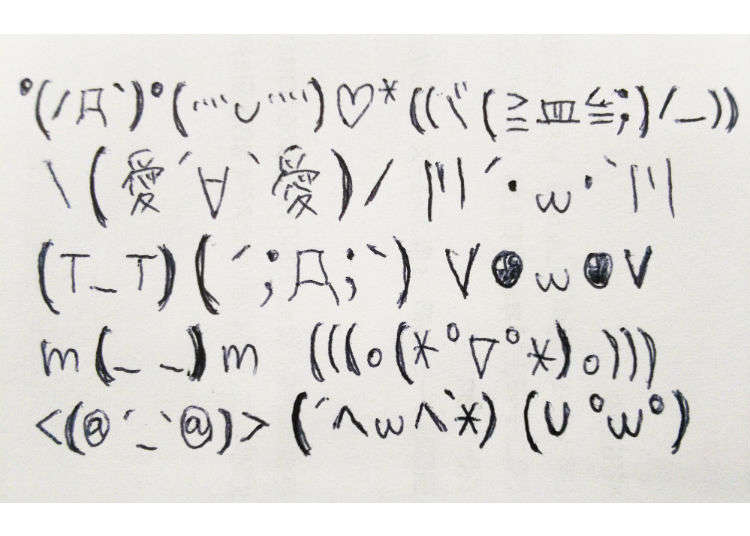
In the age of social media, we’re encouraged to say everything as short and sweet as possible. Character limits, along with short attention spans, create an environment where we need to express our thoughts fast. As a result, our written language has adapted to express our emotions quickly and effectively with emoji and emoticons. But not all emoji and emoticon are the same, and Japanese emoji do it best. So, here is everything you need to know about Japanese emoji, plus the emoji goods you need to buy!
Japanese Emoji and Emoticons
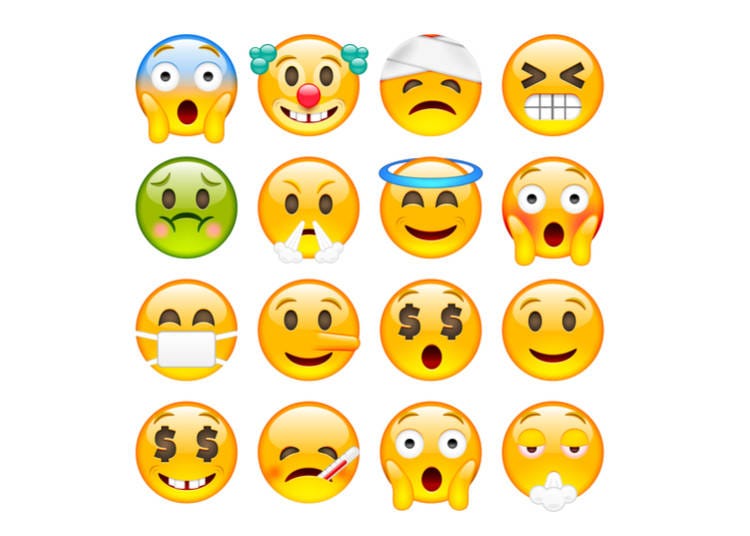
What’s so special about Japanese emoji and emoticons? Well, the first thing you may notice about Japanese emoji, or kaomoji (顔文字), is how elaborate they are. Thanks to this, kaomoji, a combination of the characters ‘kao’ (顔 meaning ‘face’) and ‘moji’ (文字 meaning ‘character), capture facial expressions and emotions much better than its English language counterpart. Japanese emoji reflect Japanese cultural references.
When reading facial expressions in Japan, the emphasis is on the eyes. While in America, emphasis is on the mouth. This is why you’ll notice Japanese emoji are right-side up while English emoji are sideways. Also, Japanese emoji and emoticons depict Japanese customs, foods, and holidays that otherwise would make little sense in the West.
Emotion-based Japanese Emoji
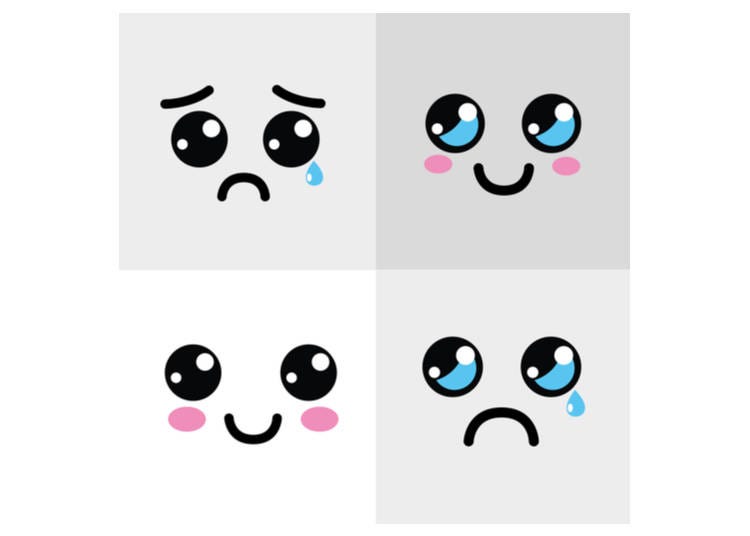
The most popular way of using emoji is to express emotion. And using kaomoji, you have many options to show each emotion. Here are some of the basics:
Happy
(≧∇≦)/
_へ__(‾◡◝ )>
(ノ・∀・)ノ
(^v^)
(^_^)
(´へωへ`*)
(◕‿◕✿)
/人◕ ‿‿ ◕人\
(=^・^=)
♪♪v(⌒o⌒)v♪♪
(((o(*゚▽゚*)o)))
\(T∇T)/
Nothing could make Tyra Banks more proud than these Japanese emoji — they are the definition of ‘smizing’. Aside from the cheerful eyes, you’ll also see big smiles, hands in the air victoriously, and even stars and music notes.
Sad
(´;Д;`)
(✖╭╮✖)
( ; ; )
( ´•̥̥̥ω•̥̥̥` )
\(@;◇;@)/
・(/Д`)・
˚‧º·(˚ ˃̣̣̥⌓˂̣̣̥ )‧º·˚
(ᗒᗣᗕ)՞
(-人-。)
(T_T)
(ρ゚∩゚)
( p_q)
Sad kaomoji range from slightly upset to full on breakdown. Sad Japanese emoji have downturned eyes, frowns, and tears.
Angry
(╯°□°)╯︵ ┻━┻
t(=n=)
(。+・`ω・´)
(`Δ´)!
(♯▼皿▼)
Σ(▼□▼メ)
૮( ᵒ̌皿ᵒ̌ )ა
ŎUŎ
((ヾ(≧皿≦;)ノ_))
p( Ò ‸ Ó)q
( ꒪Д꒪)ノ
ヽ(#゚Д゚)ノ┌┛
Angry emoji are truly dynamic and possibly the most varied. You can easily find one that will express exactly how you feel. Kaomoji can express yelling, tantrums, and flipping the bird. My personal favorite are the kaomoji flipping tables.
Sorry
m(_ _)m
m(¬0¬)m
<(_ _)>
o(_ _;o)
_| ̄|●
(m。_ _)/
(ノ_.)ノ
/(* o */)≡(\* o *)\
へ(´д`へ)
(シ_ _)シ
m(_ _;m)
<(@´_`@)>
One particular emoji unique to Japanese kaomoji is the sorry emoji. Apologizing is extremely important in Japanese culture, so unsurprisingly, Japanese emoji can express this sentiment, too. As per cultural norms, Japanese kaomoji that are apologizing bow.
Love
(灬♥ω♥灬)
(♥ω♥ ) ~♪
⊂(♡⌂♡)⊃
(´∀`)♡
♡♡+.゚(→ε←*)゚+.゚
ε=(。♡ˇд ˇ♡。)
(♡ >ω< ♡)
(⺣◡⺣)♡*
ヽ(愛´∀`愛)ノ
٩(*❛⊰❛)ʓਡ~❤
♡( ૢ⁼̴̤̆ ꇴ ⁼̴̤̆ ૢ)~ෆ♡
♡。゚.(*♡´‿` 人´‿` ♡*)゚♡ °・
Expressing love in Japanese emoji is just as kawaii as you would imagine. Hearts, stars, and kissy faces give you the general idea.
Animal Emoji
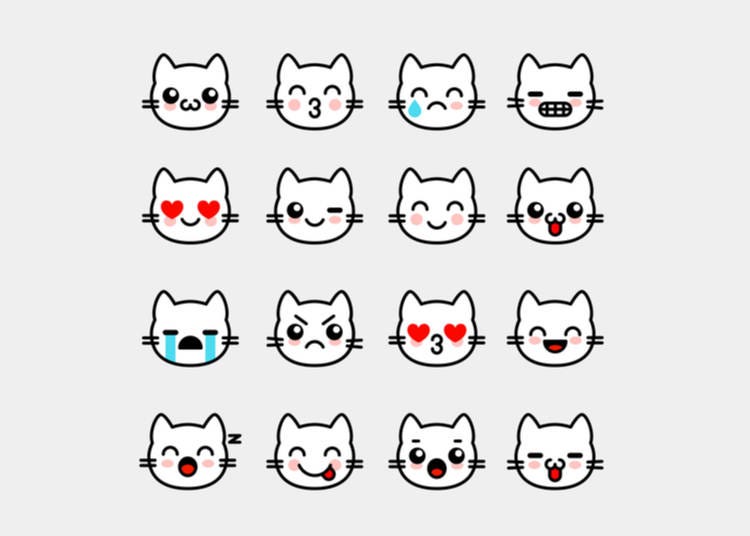
Aside from emotions, Japanese kaomoji are also known for representing animals. Why? Just because. These Japanese emoji can still show many emotions, but they have special ears and mouths. Here are a couple of examples:
Bears
(/ ̄(エ) ̄)/
ʕ •́؈•̀ ₎
ต( ິᵒ̴̶̷̤́ᆺ⃘ᵒ̴̶̷̤̀ )ິต
ʕノ•ᴥ•ʔノ ︵ ┻━┻
◟ʕ´∀`ʔ◞◟ʕ´∀`ʔ ◞
┐(´(エ)`)┌
。゜(゜^ェ^゜)゜。
☆。、::。.::・’゚\\ ̄(エ) ̄)♪clap clap♪( ̄(エ) ̄//゚’・::.。::、。☆
ʕु•̫͡•ʔु☂
( (ミ´ω`ミ))
( ̄(仝) ̄)人( ̄(仝) ̄)人( ̄(仝) ̄)
川´・ω・`川
Bear kaomoji are very popular. There’s even a Winnie the Pooh bear Japanese emoji. The snout is the most important part to making a bear emoji.
Cats
(=ↀωↀ=)✧
ヾ(*ΦωΦ)ノ
(^._.^)ノ
(^*・.・*^)
(*✧×✧*)
[^._.^]ノ彡
=^._.^= ∫
|˄·͈༝·͈˄₎.。oO
~(=^・・^)ノ>゚)##)彡
~(=^・ω・^)ヾ(^^ )
【~~~ヽ(=^‥^=)丿~~~】
(*・∀・)/(=^・^=)
Japanese cats are a symbol of kawaii culture, and cat kaomoji are just as adorable. The key to making Japanese cat emoji are the whiskers.
Dogs
V●ᴥ●V
(❍ᴥ❍ʋ)
ฅ^•ﻌ•^ฅ
V◕ฺω◕ฺV
(꒪ω꒪υ)
(∪^ω^)
(〓 ̄(∵エ∵) ̄〓)
▽・w・▽
⎩ ♨ᴥ♨ ⎭
ヾ(;゚皿゚)ノ・・・ ⊆ ̄U)┬┬ノ~” =3 =3
♪♪♪ U・ェ・U人(^・x・^=) ♪♪♪
⊆ ̄U)┬┬ノ~
While dogs are a man’s best friend, not so much so on text. Dog kaomoji are not as popular as bears or cats, but they are still adorable. The ears are most important with dog emoji, and you can choose from a bunch of them!
Japanese Emoji Goodies
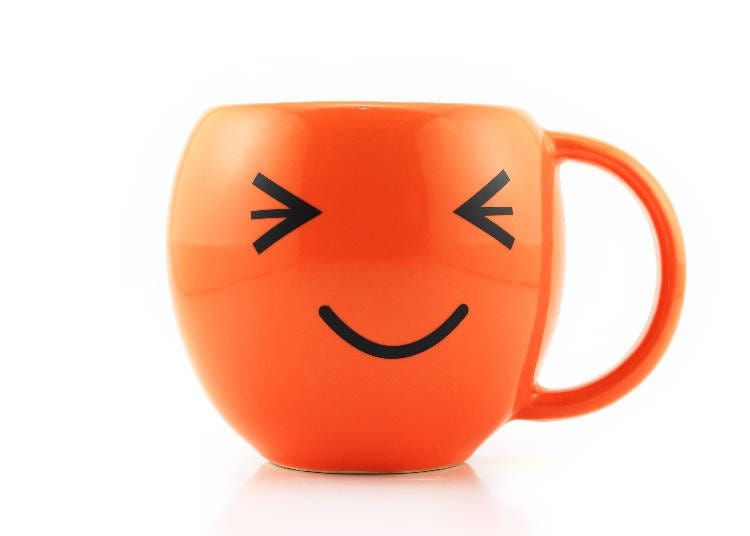
Now that you know a bit about Japanese emoji, it’s time to introduce kaomoji fashion. You can find kaomoji on all sorts of goods from t-shirts to mugs! Here are four kaomoji goodies you should get ASAP:
Phone Straps
Remind yourself to use Japanese emoji next time with a cute phone strap. Typically a soft squishy ball, these kaomoji phone straps won’t hurt your phone. In fact, some of them are even made of a screen cleaning fabric! Cute and functional all in one! Find these all over, from the stalls in front of Sensoji to the little shops on Takeshita Street.
Clothing
For those days you just don’t feel like talking, kaomoji clothing will help you express yourself. Most commonly found as t-shirts, you can also find Japanese emoji and emoticon hoodies, hats, and sweaters. You can find kaomoji shirts online as well as in more touristy locations in Tokyo. Try the shops in Shibuya or Sparkle in Asakusa.
Mugs
Need something for that coffee lover in your life? Then keep an eye out for emoji mugs. These cups can smile for you until the caffeine kicks in around 10am. Emoji mugs may be a bit more difficult to find; look in souvenir shops like the ones in Lalaport and VenusFort in Odaiba or pick one up online.
Face Masks
Looking for something that says ‘Japan’? Look no further than a kaomoji face mask. These cute little masks are made of cloth, so you can disinfect them after a day of constant coughing. And maybe best of all, they’ll look cute for you even when you don’t feel like it at all.
Japanese emoji show every little emotion. Using kaomoji, you can better express yourself. So, try some Japanese emoji next time you text your friend, and pick up some kaomoji goods in Tokyo for super cute and expressive gifts!
*Prices and options mentioned are subject to change.
*Unless stated otherwise, all prices include tax.
Popular Tours & Activitiess
Recommended places for you
-
Appealing

Odori Park
Parks
Sapporo / Chitose
-
Appealing

Rukku and Uohei
Izakaya
Sapporo / Chitose
-
Appealing

Kanemori Red Brick Warehouse
Shopping Malls
Hakodate
-
Appealing

Sapporo Ramen Yokocho
Ramen
Sapporo / Chitose
-
Appealing

Mt. Hakodate Observatory
Forests & Mountains
Hakodate
-

Niseko Village Ski Resort
Skiing & Snowboarding
Niseko / Rusutsu
-

First Japan Cherry Blossom 2026 Forecast Announced! Here's When & Where to See Sakura in Japan
-
Ad

Discover the "Miraculous Forest" in the Heart of Tokyo: The Institute for Nature Study (9 Minutes from JR Meguro Station)
-
Ad

Preserving the Beauty of World Heritage Site Shirakawa-go for the Future Through Responsible Travel
-

Jujutsu Kaisen Takes Over JR East With a Wrapped Shinkansen This Winter
by: Guest Contributor
-

Strawberries, Style, and Tokyo’s Coolest Neighborhood: Winter Afternoon Tea in Kichijoji
by: Guest Contributor
-

This Winter, Godzilla Takes Over Haneda Airport
by: Guest Contributor
-

Top 6 Artsy Activities in Otaru: Hokkaido's Home of Glassworks, Music Boxes & More!
-

Japan's North Has Such a Sweet Tooth! Checking Out Kitakaro Sapporo's Amazing Selection
-

Day Trip from Sapporo to Otaru: Access, Itinerary & Food Guide
by: Guest Contributor
-

Hokkaido Lavender Fields: 6 Best Places in Furano to See Japan's Dreamiest Purple Meadows
by: Nobuka Kawashima
-

(Video) Walking Tour along Narita Omotesando - Quaint Historical Village near Narita Airport!
by: Victor Gonzalez
-

Cheap and Delicious! 3 Popular Conveyor Belt Sushi Restaurants in Sapporo
- #best sushi hokkaido
- #things to do hokkaido
- #best ramen sapporo
- #what to bring to japan
- #new years in tokyo
- #what to buy in ameyoko
- #japanese nail trends
- #what to do in odaiba
- #onsen tattoo friendly tokyo
- #daiso
- #best sweets otaru
- #japanese fashion culture
- #best nature furano
- #japanese convenience store snacks
- #best japanese soft drinks
















